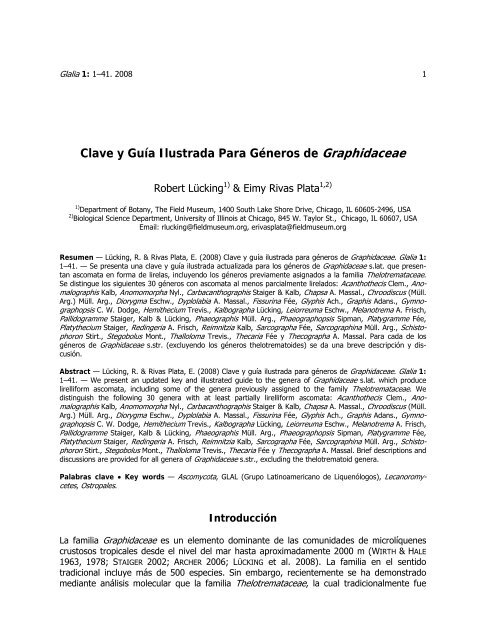2 Lücking & Rivas-Plata: Clave Para Graphidaceae
2 Lücking & Rivas-Plata: Clave Para Graphidaceae
2 Lücking & Rivas-Plata: Clave Para Graphidaceae
Create successful ePaper yourself
Turn your PDF publications into a flip-book with our unique Google optimized e-Paper software.
Glalia 1: 1–41. 2008 1<br />
<strong>Clave</strong> y Guía Ilustrada <strong>Para</strong> Géneros de <strong>Graphidaceae</strong><br />
Robert <strong>Lücking</strong> 1) & Eimy <strong>Rivas</strong> <strong>Plata</strong> 1,2)<br />
1) Department of Botany, The Field Museum, 1400 South Lake Shore Drive, Chicago, IL 60605-2496, USA<br />
2) Biological Science Department, University of Illinois at Chicago, 845 W. Taylor St., Chicago, IL 60607, USA<br />
Email: rlucking@fieldmuseum.org, erivasplata@fieldmuseum.org<br />
Resumen — <strong>Lücking</strong>, R. & <strong>Rivas</strong> <strong>Plata</strong>, E. (2008) <strong>Clave</strong> y guía ilustrada para géneros de <strong>Graphidaceae</strong>. Glalia 1:<br />
1–41. — Se presenta una clave y guía ilustrada actualizada para los géneros de <strong>Graphidaceae</strong> s.lat. que presentan<br />
ascomata en forma de lirelas, incluyendo los géneros previamente asignados a la familia Thelotremataceae.<br />
Se distingue los siguientes 30 géneros con ascomata al menos parcialmente lirelados: Acanthothecis Clem., Anomalographis<br />
Kalb, Anomomorpha Nyl., Carbacanthographis Staiger & Kalb, Chapsa A. Massal., Chroodiscus (Müll.<br />
Arg.) Müll. Arg., Diorygma Eschw., Dyplolabia A. Massal., Fissurina Fée, Glyphis Ach., Graphis Adans., Gymnographopsis<br />
C. W. Dodge, Hemithecium Trevis., Kalbographa <strong>Lücking</strong>, Leiorreuma Eschw., Melanotrema A. Frisch,<br />
Pallidogramme Staiger, Kalb & <strong>Lücking</strong>, Phaeographis Müll. Arg., Phaeographopsis Sipman, Platygramme Fée,<br />
Platythecium Staiger, Redingeria A. Frisch, Reimnitzia Kalb, Sarcographa Fée, Sarcographina Müll. Arg., Schistophoron<br />
Stirt., Stegobolus Mont., Thalloloma Trevis., Thecaria Fée y Thecographa A. Massal. <strong>Para</strong> cada de los<br />
géneros de <strong>Graphidaceae</strong> s.str. (excluyendo los géneros thelotrematoides) se da una breve descripción y discusión.<br />
Abstract — <strong>Lücking</strong>, R. & <strong>Rivas</strong> <strong>Plata</strong>, E. (2008) <strong>Clave</strong> y guía ilustrada para géneros de <strong>Graphidaceae</strong>. Glalia 1:<br />
1–41. — We present an updated key and illustrated guide to the genera of <strong>Graphidaceae</strong> s.lat. which produce<br />
lirelliform ascomata, including some of the genera previously assigned to the family Thelotremataceae. We<br />
distinguish the following 30 genera with at least partially lirelliform ascomata: Acanthothecis Clem., Anomalographis<br />
Kalb, Anomomorpha Nyl., Carbacanthographis Staiger & Kalb, Chapsa A. Massal., Chroodiscus (Müll.<br />
Arg.) Müll. Arg., Diorygma Eschw., Dyplolabia A. Massal., Fissurina Fée, Glyphis Ach., Graphis Adans., Gymnographopsis<br />
C. W. Dodge, Hemithecium Trevis., Kalbographa <strong>Lücking</strong>, Leiorreuma Eschw., Melanotrema A. Frisch,<br />
Pallidogramme Staiger, Kalb & <strong>Lücking</strong>, Phaeographis Müll. Arg., Phaeographopsis Sipman, Platygramme Fée,<br />
Platythecium Staiger, Redingeria A. Frisch, Reimnitzia Kalb, Sarcographa Fée, Sarcographina Müll. Arg., Schistophoron<br />
Stirt., Stegobolus Mont., Thalloloma Trevis., Thecaria Fée y Thecographa A. Massal. Brief descriptions and<br />
discussions are provided for all genera of <strong>Graphidaceae</strong> s.str., excluding the thelotrematoid genera.<br />
Palabras clave • Key words — Ascomycota, GLAL (Grupo Latinoamericano de Liquenólogos), Lecanoromycetes,<br />
Ostropales.<br />
Introducción<br />
La familia <strong>Graphidaceae</strong> es un elemento dominante de las comunidades de microlíquenes<br />
crustosos tropicales desde el nivel del mar hasta aproximadamente 2000 m (WIRTH & HALE<br />
1963, 1978; STAIGER 2002; ARCHER 2006; LÜCKING et al. 2008). La familia en el sentido<br />
tradicional incluye más de 500 especies. Sin embargo, recientemente se ha demonstrado<br />
mediante análisis molecular que la familia Thelotremataceae, la cual tradicionalmente fue

















